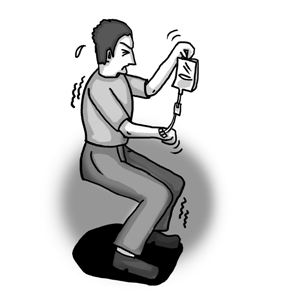Time to cut out the IV drip habit

Illustration: Lu Ting/GT
A local man surnamed Lin visited Shanghai East Hospital in Pudong New Area after having a high temperature for three days. He was prescribed a course of treatment via intravenous drip. However, when he arrived in the room where the treatment was to be administered, he found that all the 40 or so chairs for intravenous therapy, which have soft back-and armrests, were occupied. He had to instead sit on a hard steel chair with no armrests. This meant he had to keep his arm raised for more than three hours as he received his treatment. By the end, his arm was so sore it was almost numb.
Lin complained about his experience to local media, who conducted an immediate investigation into the hospital. The hospital quickly responded that it will soon purchase some 70 more specialized IV drip armchairs to cater for its increasing number of patients.
However, I don't think it is right to give so many patients intravenous therapy, especially when their illnesses are minor colds and fevers.
It is far from rare to find the IV treatment rooms of hospitals crowded with patients. In an investigation conducted by the Shanghai Morning Post, several other hospitals whose IV drip chairs number between 100 and 200 are barely able to meet demand.
According to figures released by the National Development and Reform Commission (NDRC) in 2009, as many as 10.4 billion doses of IV medicine were administered in China in 2009, averaging eight per person, far beyond the international average of 2.5 to 3.3 doses per person.
According to the medication principle recommended by the WHO, choosing oral medicine over intramuscular injection, and injections over IV, intravenous infusion is the last medication method that doctors will resort to in many advanced countries.
Deng Haihua, deputy director of the general office of the then Ministry of Health, later said not all the 10.4 billion doses given in the NDRC figures are used in IV therapy, as a proportion is used in surgery and hemodialysis. However, it is indeed a fact that Chinese doctors prescribe intravenous infusion far more often than the world's average. But we cannot put all the blame on doctors. Although some unscrupulous doctors do prescribe expensive IV drips due to the linkage between Chinese doctors' income and the medicines they prescribe, on many occasions, Chinese doctors give prescriptions due to the strong demand from patients.
Chinese enthusiasm for IV treatment can be attributed to the desire for instant results. Drugs can act quicker in IV treatment, entering the bloodstream directly, and circulating in the body within 20 seconds. Without any professional medical knowledge, many patients believe strong and expensive medicine is always better than mild and cheap medicine, and therefore that IV drips are always better than oral medicine. As such, IV drips have come to be considered as a common form of medicating by many Chinese. They also know nothing about the side effects and risks of IV treatment, such as tainted drugs or anaphylaxis that can lead to shock or death.
Today's Chinese doctors have become a vulnerable and disadvantaged group who are often attacked by patients or patients' relatives. Under pressure from patients and their family members requesting IV treatment immediately, many doctors cave in to the demands.
However, in other countries, doctors are respected and it is hard to believe that patients would demand a particular prescription from doctors and get it.
So, I think hospital authorities should actually decrease the number of chairs available for patients receiving IV treatment in a bid to persuade those patients who can be treated by oral medicine or injections to go home. This will leave more seats available to patients like Lin who are in real need of an IV drip. This will also be an effective way of decreasing the overall number of IV treatments and the abuse of antibiotics.